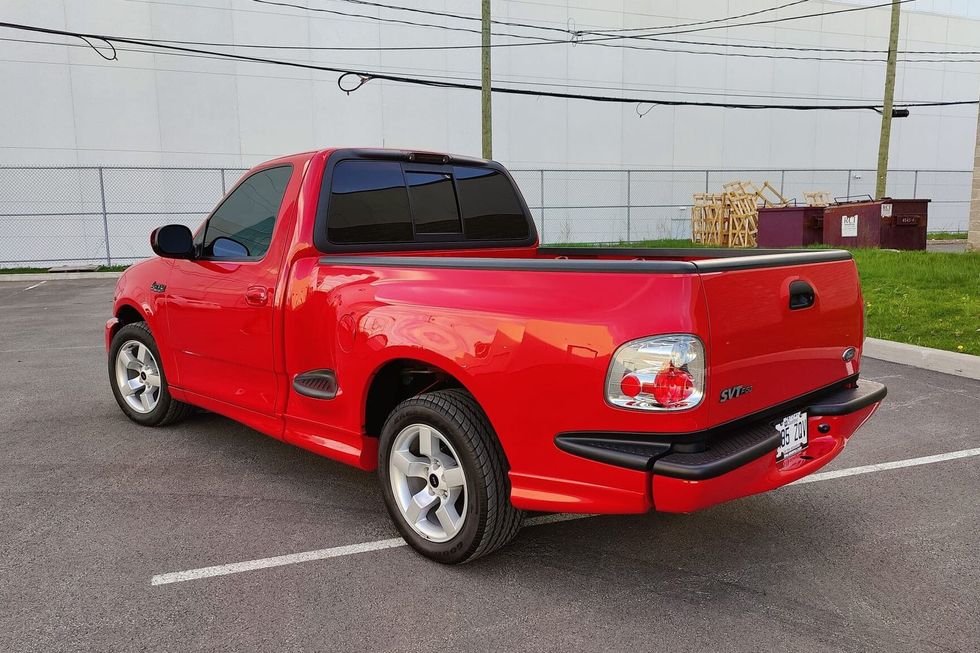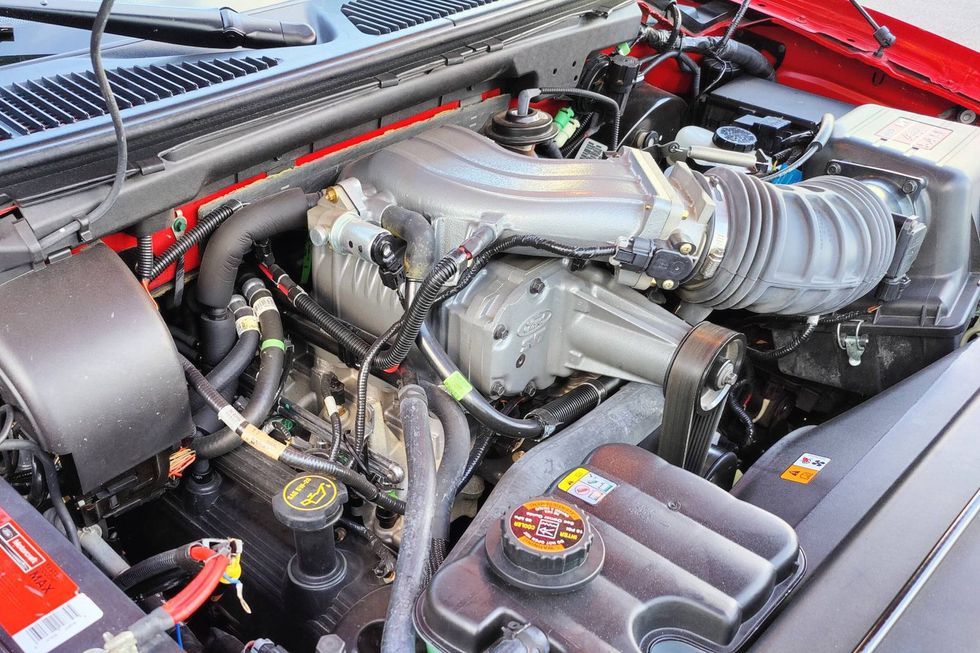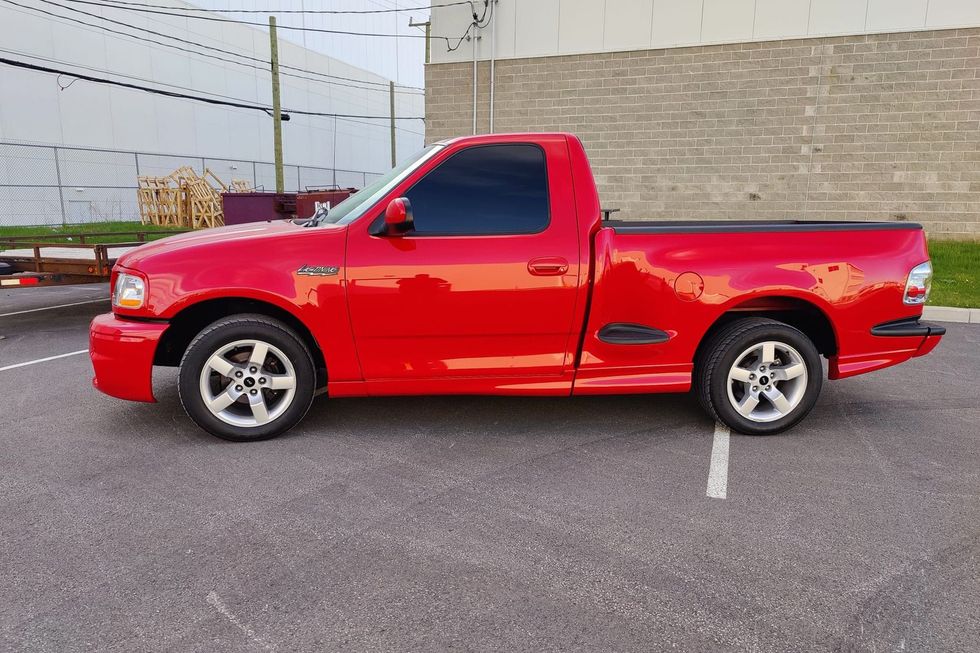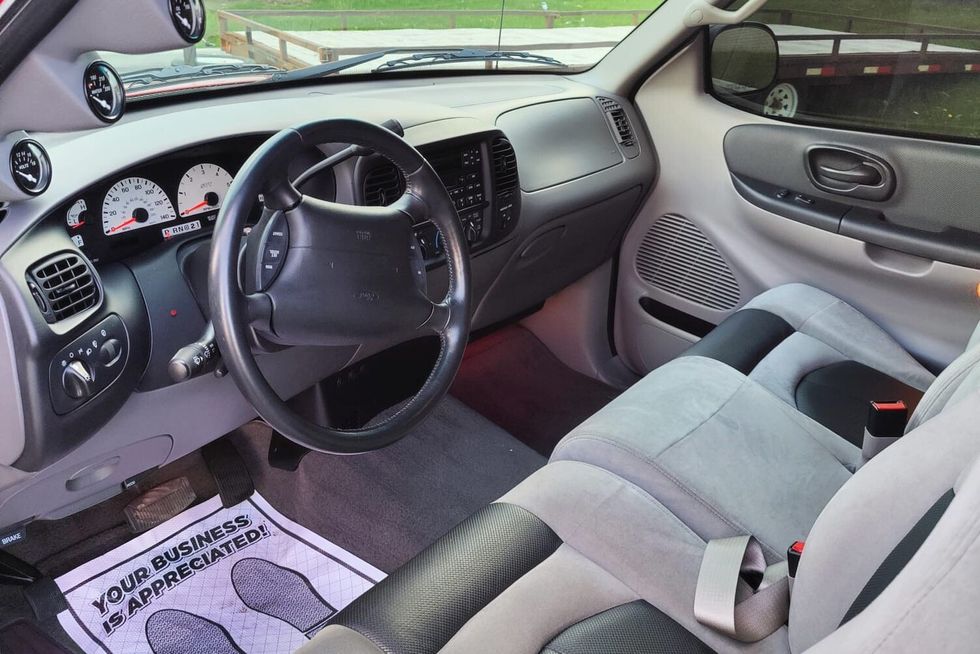Skin and Bones - 1974 Lotus Europa
Drivetrain? Check. Something to hold it in? Check. And you've got yourself a 1974 Lotus Europa Twin Cam Special
09/23/2018


This passage in the Europa technical manual is immediately followed by the section about replacing the chassis, and how it can't be repaired. You can't sum up the Lotus engineering philosophy much better than that. They weren't fragile, exactly, but the Lotus owner had to know what he was getting into.
So now let's get the obligatory discussion about how it looks out of the way, and then we can all get on with our lives: It's funny-looking. It's flat in a .29 coefficient of drag way. It's weird in a way that reminds you that the designer, Lotus chief engineer Ron Hickman, was working on Lotus's Ford GT40 proposal when he sketched it out. That's right, if things had worked out a little differently, Europas, in their trademark blue and orange livery, might be million-dollar collectibles today. This was a shape with a very simple purpose: Get through the air, fast. They made a couple of concessions for the need to hold a person inside, and maybe cover some stuff up, but if you're looking for Figoni et Falaschi coachbuilding, you're missing the point. O.K., it's not the kind of beauty that doesn't hurt your eyes, but the thing up and goes, so who cares?

We often hear questions along the lines of, "With a car as beautiful as the Elite around, why develop that thing in the first place?" The Europa wasn't a replacement for the Elite, that's why. Lotus's Colin Chapman wanted a replacement for the immortal Lotus 7 roadster, a light, simple, dedicated road racing car. Chapman envisaged it a continental Lotus, a very real translation of sports car racing for the open road.
Centered on a Lotus Elan-derived central backbone chassis, development extended over several years, as Chapman and company searched for an appropriate drivetrain. He found it at the Paris Motor Show, in the form of the new front-wheel-drive Renault 16's alloy 1,470cc inline-four and four-speed. Something about that configuration struck him as perfect for a mid-engined vehicle, and sure enough, with the engine turned 90 degrees and final drive reversed, it fit the Y-shaped rear frame.

They reached an agreement, and Renault sold Lotus a hi-po, c. 80hp version (up 50 percent over the stock Renault) for the Series 1 Europa. Underneath, Lotus used a version of Triumph's outstanding, ubiquitous double-wishbone front suspension, with hubs and Girling brake discs from the Vitesse/GT6, and modified Elan (née Triumph) steering gear.
Chapman wanted the Europa to be a car that didn't require a race shop to repair or maintain, but Lotus bonded the fiberglass body to the pressed-steel frame for stiffness. Countless owners since have found this the scourge of the model, as it can't be removed without destroying it, and the main shell is one enormous blow-molded piece of often-indifferent quality. The compound curve shape fixed the side windows in place, and they developed a ventilation system via hoses from a sealed front luggage compartment. Effective, but the journey during which something went wrong was a descent into hell.
The Elan was still selling well in the U.K. and U.S.A., so the Series 1 Type 46 Europa was only sold in mainland Europe. An initial shipment of 500 cars was delivered to France, and some 644 are recorded as having been produced.
It was funky, slippery, wonderful--and slow. With only 80hp and a four-speed, it was aero enough to make 115 mph, but by the time you got there, the sun had exploded and a giant cockroach issued your speeding ticket. Even today, there are sightings of ancient graybeards on the autobahn with their foot on the floor. Eighty horsepower. That's why, every year on his birthday, Europa owners all over the world light a single turn signal for Lotus's Mike Kimberly.
Lotus upgraded the Europa in 1968, introducing the Type 54 Series 2, whose major improvement was a removable body shell. Aside from some minor tweaks to the bodywork, operating windows and a greatly improved (and slightly larger) interior, the car was almost unchanged, the R16 engine wheezing up to 82hp. They graced the U.S. market with a 1,565cc Type 65 "Federal" version, smogged down to 80hp. Most notably, Lotus jacked up the front end some two inches to meet headlamp height regulations. American owners have been jacking the awkward-looking result back down ever since.

Renault forced Lotus's hand in 1970, when they discontinued the powerplant. They'd always held onto the best stuff, thinking that a home-market 120hp version would make the Europa into Alpine competition, and engineer Mike Kimberly had been chafing at the idea that there was 50 percent more horsepower available, not just at Renault, but from the racing variant's twin-cam. Even as Renault was pulling out, he was hard at work adapting the race engine for the street.
Renault still supplied the four-speed transaxle, so Lotus held the Twin Cam's (as 1971's Type 74 was known) LF/105 1,558cc four to 105hp. The look was obviously Europa, but the exterior was largely new, with a profile that lasted through the final sales in 1975. Lotus sold around 1,600 in two years, with profits that emboldened them to pursue the ultimate variant, the "Big Valve" Europa Special. The same 1,558cc engine realized its full potential, with 126 horsepower and a new Renault five-speed transaxle. Zero-60 times, already under seven seconds for the Twin Cam, headed down toward six seconds, top speed up toward 125, with all the handling goodness of previous models.
Andy Tomaszewski's 1974 Twin Cam Special is one of these, in John Player Special livery commemorating Lotus's F1 championships. It actually started out as a ridiculously rare Roman Purple car, but the previous owner had painted it in black and gold JPS livery, and honestly, would you paint it purple?
It came as something better than a basket case, "but the car had sat for a while," said Andy. "She needed some TLC...I needed to fix the transmission and brakes to make the car driveable, then basically rebuilt all the mechanicals over the following five years."
In addition to the paint, she came with a Lotus Elan Weber head and 40DCOE carburetors in place of the factory Zenith-Strombergs. Andy, an inveterate tinkerer, has gradually made other upgrades and modifications to suit his driving style over the 15 or so years he's owned it. Most obviously, he dropped the front end almost two inches to match the European car's ride height, but has also built himself a custom exhaust header, replaced the front discs with 10-inch Elan discs, machined himself an adjustable rear lateral link and had engine work done. None of that made it any bigger, though.
L. J. K. Setright reported in the February 1967 Car that he visited the factory and found "the designers and development engineers are all little men, trim and bantam-sized like Chapman himself." It's the single greatest bar to Europa ownership: No one over 5'10" need apply.
As per Andy's instructions, we brought driving shoes for our drive...he should have told us to wear our small feet. The engine is about eight inches behind your head, the road is knuckle-draggingly close...our left foot brushed the brake. Thankfully, the steering wheel was at a good distance, and after a banzai familiarization drive by Andy, we were off.
Our first 15 minutes behind the wheel was an exercise in frustration. The combination of a long, long mechanical linkage to the end of the transaxle at the back of the car, and a gearshift pattern we couldn't wrap our minds around, meant we utterly failed to change gears well. Hey, at least we admit it. However, we had more than 15 minutes, and eventually realized that third gear was there, and first was there, and we could concentrate on, you know, driving.
The ride was outstanding, well-damped but communicative, and Andy says that before he started beefing up the suspension, it verged on plush. It stays flat, the close pedals allow for easy heel and toe--if you know where your right hand is supposed to go--and the engine note is pure English four-cylinder perfection. The tiny front end does mean you'd better be doing leg presses if you plan to be in a collision (Andy has air horns for anti-Escalade purposes), but also allows you to put the front end exactly where you want it, in an I-think-I'd-like-to-pass-between-those-two-leaves sense. When he was driving and gave it the boot, the biggest surprise was the real kick in the back it delivers. Two people in it add another 15 percent to the weight, so the thing's a real screamer with just one--we have to think that Andy's punched-out version might duck into the high five-second range.
Not only did the original Twin Cam make the Special possible, it gave Lotus the resources to launch their first supercar, the Esprit, just a few years later. Without it, they would not today be one of a tiny number of British carmakers to survive into the 21st century. And as we all know, beauty is in the eye of the beholder. "I have found this car very desirable since I first saw it when I was around 12 years old," said Andy. "When the open road is available, you can carve through the twisties...and it takes hours to wipe the smile off your face." We know we're still grinning today.
Andy Tomaszewski had his first interior assembled by a local upholsterer, in vinyl at his recommendation. "Shortly after the work was done, I had left the car out on a warm day," he said. "When I returned to the car, much of the adhesive the upholsterer had used had released. I took the car back, and they reapplied the adhesive, but the same failure happened."
So he did the obvious thing: purchased a commercial sewing machine and went to work. After an initial template, "I made the commitment by seam ripping the seats, console, etc., to make patterns."
"Overall, I am very pleased with the outcome, and the best thing is the adhesive I used doesn't release in the heat but probably depleted the ozone a little more."
Owner's Story
It's the closest thing to driving a Formula Ford race car on the street...the handling and performance always bring a smile to your face when spirited driving is safe. I also find the lines of the car very beautiful.
When I was 12, my brother and cousin would let me tag along to autocrosses with them, and there were a couple of Europas that would show up and pretty much beat everything else in their class every weekend. I already liked the shape of the car, and this just further endeared it to me.
Early Lotus cars are not for everyone. They are drivers' cars, fragile and lacking luxuries that most people expect today. If you want a true sports car and enjoy driving, then there isn't a better marque around.
-Andy Tomaszewski
What to Pay
1974 Lotus Europa Twin Cam Special
Low: $6,000
Avg: $8,000
High: $20,000
Club Scene
Lotus, Ltd.
P.O. Box L
College Park, Maryland 20741
301-982-4054
www.lotuscarclub.org
Dues: $35; Membership: 1,500
Pros & Cons
Pros
Blistering speed
Absurd roadholding
Greatest of the variants
Cons
Starting to get pricey
Best view out is from the driver's seat
Assuming you can get into it
SPECIFICATIONS
ENGINE
Type: Cast-iron DOHC inline-four, alloy head, solid skirt alloy pistons, hemispherical combustion chambers
Displacement: 1,558cc (95.06-cu.in.) stock/1,756cc actual
Bore X stroke: 82.55 x 72.75 stock/87.65 X 72.75 mm actual
Compression ratio: 10.3:1
Horsepower @ rpm: 126 @ 6,500
Torque @ rpm: 113-lbs.ft. @ 5,500
Main bearings: 5
Fuel system: Twin Weber 40 DCOE sidedraft
Ignition system: 12-volt, Pertronix pointless, AC Delco 35-amp alternator, Lucas M.35 J starter
Lubrication system: Gear driven, full pressure eccentric lobe
Exhaust system: Single, four-into-one header
TRANSMISSION
Type: Renault 365 five-speed manual
Ratios: 1st 3.61:1
2nd: 2.33:1
3rd: 1.61:1
4th: 1.21:1
5th: 0.87:1
Reverse: 3.08:1
DIFFERENTIAL
Type: Renault, hypoid final drive
Ratio: 3.78:1
STEERING
Type: Rack and pinion
Turns, lock-to-lock: 2.7
Turning circle: 41 feet
BRAKES
Type: Girling hydraulic
Front: 9.5-inch disc (stock)/10-inch disc (actual)
Rear: 8.0 X 1.5-inch drum
CHASSIS & BODY
Construction: Fiberglass layup over sheet steel backbone
Body style: Two-passenger coupe
Layout: Rear mid engine, rear-wheel drive
SUSPENSION
Front: Independent; unequal length A-arms, Spax adjustable coil-over shocks, anti-sway bar
Rear: Independent; Chapman struts, coil-over Spax adjustable shocks, adjustable lateral links
Wheels: American Racing forged four-lug
Front/rear: 14 X 6 inches
Tires: Dunlop D60 radial
Front/rear: 180/60-14
WEIGHTS & MEASURES
Wheelbase: 92 inches
Overall length: 157.5 inches
Overall width: 64.5 inches
Overall height: 42.5 inches
Front track: 53.5 inches
Rear track: 53 inches
Shipping weight: 1,513 pounds
CAPACITIES
Crankcase: 7 quarts
Cooling system: 11.5 quarts
Fuel tank: 15 gallons
Transmission: 3.6 pints
CALCULATED DATA
Bhp per cc: 12.37
Weight per bhp: 12.01 pounds
Weight per c.i.d.: 15.92 pounds
PERFORMANCE
0-60 mph: 6.6 seconds
¼ mile ET: 14.9 seconds
Top speed: 123 mph
(Source: Motor)
PRICE
Base Price: $7,400
Forget Ford’s groundbreaking electric truck for a moment to consider this 2001 Ford SVT F-150 Lightning now offered on Hemmings Auctions. Instead of the dual permanent-magnet motors found in the current electric Lightning, the 1999-2004 SVT Lightning featured a supercharged version of Ford’s 5.4-liter “modular” OHC V8. Rated at 380 horsepower in the 2001-’04 models, it was good enough to make a stock lightning a formidable opponent on the street as well as at the strip.
A follow-up to the original 1993-’95 F-150 Lightning, which was a high-performance version of a standard F-150, the second-generation SVT super truck presented as a more thoroughly developed model with a lot more exclusive components that further differentiated it from the rest of the F-Series lineup. Beyond the engine, the entire suspension and braking system, not to mention aerodynamic body add-ons, were part of the Lightning package from 1999 through 2004. Exclusive interior components were also part of the package.
At the heart of this SVT Lightning is its iron-block 5.4-liter SOHC, 16-valve V8 with a supercharger and an intercooler. The blower helped it deliver 380 horsepower and 450 lb-ft of torque in 2001, up some 20 horsepower and 10 lb-ft from the ’99 and 2000 models. The Eaton supercharged engine delivered peak boost of 8.0 psi and the engine featured an 8.4:1 static compression ratio, down from the standard 5.4 V8’s 9.0:1, which was rated at 260 horsepower and 350 lb-ft.
Power reached the rear 18-inch cast aluminum-alloy wheels via a four-speed automatic, an aluminum driveshaft and a beefy 9.75-inch, limited-slip rear axle with an acceleration-friendly 3.73:1 final-drive ratio, another upgrade for 2001. Car and Driver magazine reported a 0-60 mph time of 5.2 seconds and a quarter-mile in an E.T. of 13.8 seconds at 104 mph—impressive numbers for a 4,600-pound truck. Top speed was a drag-limited 142 mph.

Trucks generally require a suspension that can handle a full load in its bed while also providing competent driving while empty. But if you fancy one designed to a sports-car standard, then something has to give. In the case of the second-gen Lightning, Ford dropped its payload capacity to a mere 800 pounds. A standard 2001 F-150 Styleside carried a 3,180-pound payload rating, while an F-150 Flareside was rated at 2,005 pounds, some two-and-a-half times the Lightning, which featured the short-bed Flareside body. Towing capacity, likewise, was reduced from 8,800 pounds to 5,000 in the Lightning. But the Lightning’s strengths were never its payload or towing capacities, but it’s ability to perform like a sports car.
As a 21st century performance vehicle, however, the second-gen Lightning was also equipped to handle. A half-inch drop at the front was accompanied by SVT-specific coil springs and Bilstein shocks along with an exclusive 31-mm solid anti-roll bar. SVT’s influence continued at the rear with Lightning-specific five-leaf springs and a 23-mm solid anti-roll bar. The Bilstein setup at the rear included the right-rear shock staggered toward the front of the truck to reduce axle hop under heavy acceleration. The four-wheel antilock disc brakes were cribbed from the three-quarter-ton F-250, with 12.1-inch front rotors at the front and 13.1-inch discs at the rear.

As the years go on, fewer and fewer clean, unmolested low-mileage examples are out there, which is why this 2001 Ford SVT F150 Lightning now on Hemmings Auctions caught our attention. Showing just 5,525.5 miles on its odometer at the time of submission, it is said to be in “mint” condition and have an “immaculate” finish in the seller’s words. No modifications are noted to any part of the vehicle. The 18-inch factory alloys don’t appear to have any curb rash, though the Goodyear performance tires may be original. About the only deviations from stock are the tinted windows.
The latest electric-only F-150 Lightning is certainly a quick vehicle in its own right, but this 2001 edition from the engineers at SVT was built for excitement, not range. It was made with an old-school muscle-car vibe along with modern handling and braking. Which Lightning would you look good behind the wheel of?
Take a look at this second-gen Lightning on Hemmings Auctions before the bidding ends.

Spring is here. As the snow melts and the daffodils bloom, it’s time for many vintage cars to emerge from winter hibernation and get back on the road. Thinking of adding to the collection? We have 10 vehicles in spring-like shades of yellow – including cars and trucks, U.S. and European – to catch your eye.

















































